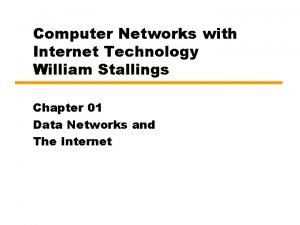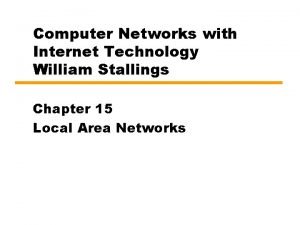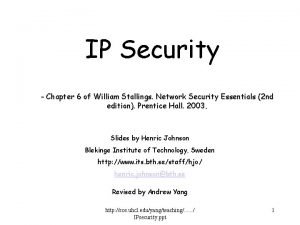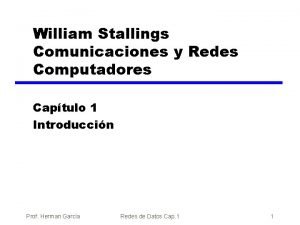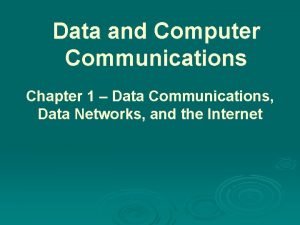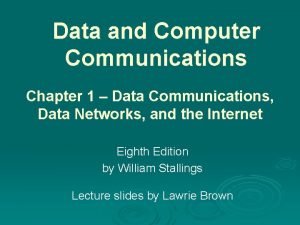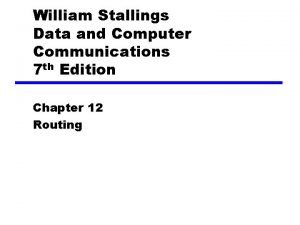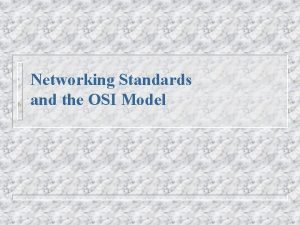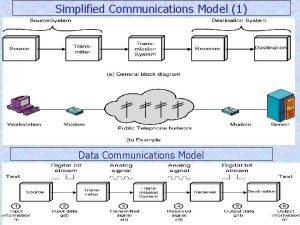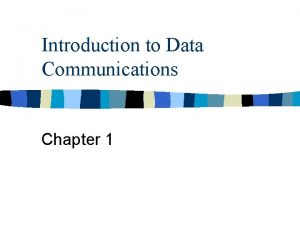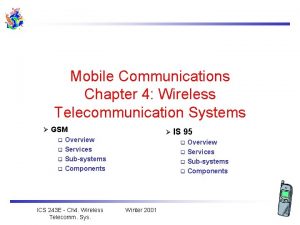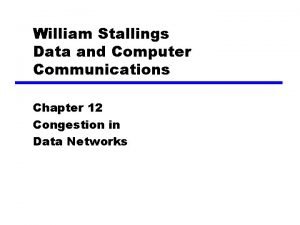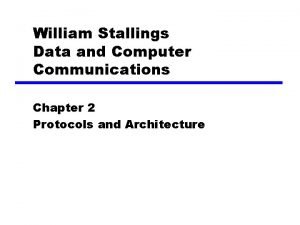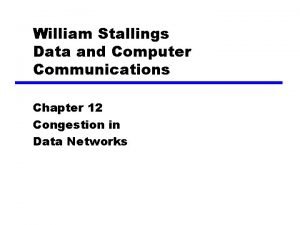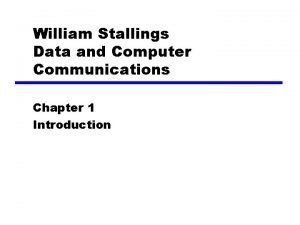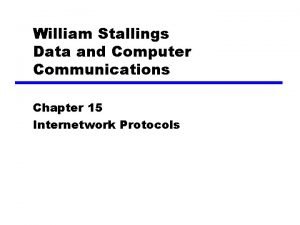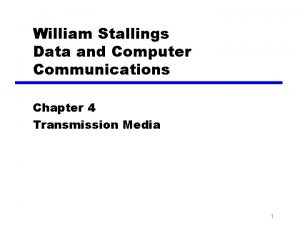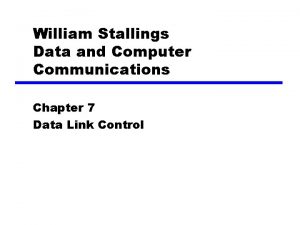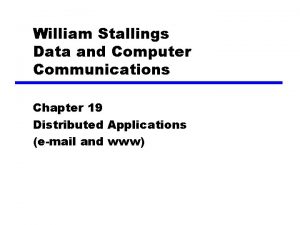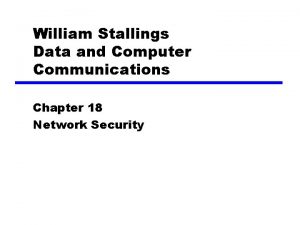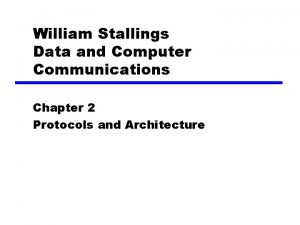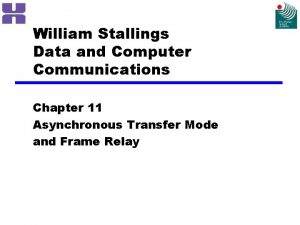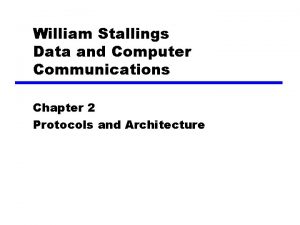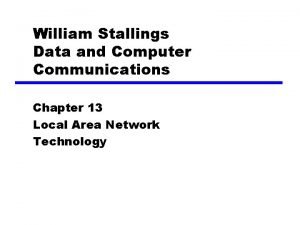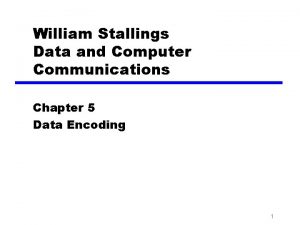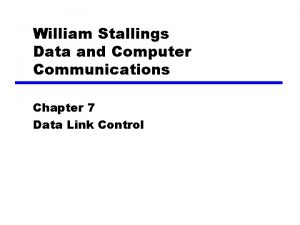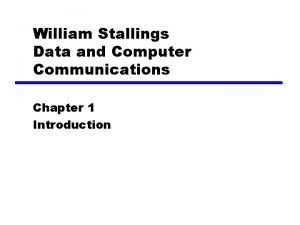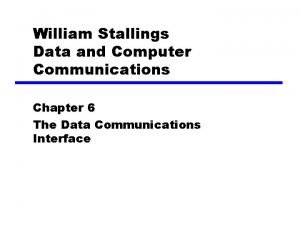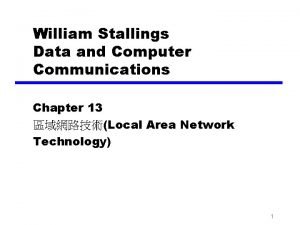William Stallings Data and Computer Communications Chapter 16
































- Slides: 32

William Stallings Data and Computer Communications Chapter 16 Internetwork Operation

Routing Protocols z Routing Information y. About topology and delays in the internet z Routing Algorithm y. Used to make routing decisions based on information

Autonomous Systems (AS) z Group of routers z Exchange information z Common routing protocol z Set of routers and networks managed by single organization z A connected network y. There is at least one route between any pair of nodes

Interior Router Protocol (IRP) z Passes routing information between routers within AS z May be more than one AS in internet z Routing algorithms and tables may differ between different AS z Routers need some info about networks outside their AS z Used exterior router protocol (ERP) z IRP needs detailed model z ERP supports summary information on reachability

Application of IRP and ERP

Border Gateway Protocol (BGP) z For use with TCP/IP internets z Preferred EGP of the Internet z Messages sent over TCP connections y. Open y. Update y. Keep alive y. Notification z Procedures y. Neighbor acquisition y. Neighbor reachability y. Network reachability

BGP Messages

Message Types z Keep Alive y. To tell other routers that this router is still here z Update y. Info about single routes through internet y. List of routes being withdrawn y. Includes path info x. Origin (IGP or EGP) x. AS_Path (list of AS traversed) x. Next_hop (IP address of boarder router) x. Multi_Exit_Disc (Info about routers internal to AS) x. Local_pref (Inform other routers within AS) x. Atomic_Aggregate, Aggregator (Uses address tree structure to reduce amount of info needed)

BGP Routing Information Exchange z Within AS, router builds topology picture using IGP z Router issues Update message to other routers outside AS using BGP z These routers exchange info with other routers in other AS z Routers must then decide best routes

Open Shortest Path First (1) z OSPF z IGP of Internet z Replaced Routing Information Protocol (RIP) z Uses Link State Routing Algorithm y. Each router keeps list of state of local links to network y. Transmits update state info y. Little traffic as messages are small and not sent often y. RFC 2328 z Route computed on least cost based on user cost metric

Open Shortest Path First (2) z Topology stored as directed graph z Vertices or nodes y. Router y. Network x. Transit x. Stub z Edges y. Graph edge ( e. g. , link) x. Connects two routers x. Connects routers to network

Sample AS

Directed Graph of AS

Operation z Dijkstra’s algorithm (Appendix 10 A) used to find least cost path to all other networks z Next hop used in routing packets

Integrates Services Architecture z Changes in traffic demands require variety of quality of service z Internet phone, multimedia, multicast z New functionality required in routers z New means of requesting Qo. S z ISA z RFC 1633

Internet Traffic z Elastic y. Can cope with wide changes in delay and/or throughput x. FTP sensitive to throughput x. E-Mail insensitive to delay x. Network Management sensitive to delay in times of heavy congestion x. Web sensitive to delay z Inelastic y. Does not easily adapt to variations ye. g. real time traffic

Requirements for Inelastic Traffic z Throughput z Delay z Jitter y. Delay variation z Packet loss z Require preferential treatment for certain types of traffic z Require elastic traffic to be supported as well

ISA Components

Token Bucket Traffic Specification z Token replenishment rate R y. Continually sustainable data rate z Bucket size B y. Amount that data rate can exceed R for short period y. During time period T amount of data sent can not exceed RT + B

Token Bucket Scheme

ISA Services z Guaranteed y. Assured data rate y. Upper bound on queuing delay y. No queuing loss y. Real time playback z Controlled load y. Approximates behavior to best efforts on unloaded network y. No specific upper bound on queuing delay y. Very high delivery success z Best Effort

Queuing Discipline z Traditionally FIFO y. No special treatment for high priority flow packets y. Large packet can hold up smaller packets y. Greedy connection can crowd out less greedy connection z Fair queuing y. Queue maintained at each output port y. Packet placed in queue for its flow y. Round robin servicing y. Skip empty queues y. Can have weighted fair queuing

FIFO and Fair Queue

Resource Reservation: RSVP z Unicast applications can reserve resources in routers to meet Qo. S z If router can not meet request, application informed z Multicast is more demanding z May be reduced y. Some members of group may not require delivery from particular source over given time xe. g. selection of one from a number of “channels” y. Some group members may only be able to handle a portion of the transmission

RSVP Goals z Ability for receivers to make reservations z Deal gracefully with changes in multicast group membership z Specify resource requirements such that aggregate resources reflect requirements z Enable receivers to select one source z Deal gracefully with changes in routes z Control protocol overhead z Independent of routing protocol

Treatment of Packets

RSVP Operation

Differentiated Services z Provide simple, easy to implement, low overhead tool to support range of network services differentiated on basis of performance z IP Packets labeled for differing Qo. S using existing IPv 4 Type of Service or IPv 6 Traffic calss z Service level agreement established between provider and customer prior to use of DS z Built in aggregation y Good scaling to larger networks and loads z Implemented by queuing and forwarding based on DS octet y No state info on packet flows stored

SLA Parameters z Detailed service performance y. Expected throughput y. Drop probability y. Latency z Constraints on ingress and egress points z Traffic profiles ye. g. token bucket parameters z Disposition of traffic in excess of profile

Example Services z Level A - low latency z Level B - low loss z Level C - 90% of traffic < 50 ms latency z Level D - 95% in profile traffic delivered z Level E - allotted twice bandwidth of level F traffic z Traffic with drop precedence X higher probability of delivery than that of Y

DS Traffic Conditioner

Required Reading z Stallings chapter 16 z RFCs identified in text z Comer, Internetworking with TCP/IP volume 1
 William stallings data and computer communications
William stallings data and computer communications Computer arithmetic
Computer arithmetic William stallings computer networks
William stallings computer networks William stallings computer networks
William stallings computer networks Network security essentials 5th edition pdf
Network security essentials 5th edition pdf Network security essentials william stallings ppt
Network security essentials william stallings ppt William stallings
William stallings William stallings
William stallings Stallings william comunicaciones y redes de computadores
Stallings william comunicaciones y redes de computadores Cryptography william stallings
Cryptography william stallings Data and computer communications 10th edition
Data and computer communications 10th edition Data and computer communication
Data and computer communication Data and computer communications
Data and computer communications Garbage collection stallings
Garbage collection stallings Garbage pickup stallings
Garbage pickup stallings Daphne and apollo story
Daphne and apollo story Metodo stallings
Metodo stallings Least cost routing algorithm
Least cost routing algorithm Telecommunication meaning
Telecommunication meaning Backbone network components
Backbone network components Business data communications and networking
Business data communications and networking Introduction to data communications and networking
Introduction to data communications and networking Business data communications and networking
Business data communications and networking Network communication models
Network communication models Chapter 4 communications and documentation quiz
Chapter 4 communications and documentation quiz Chapter 3 network protocols and communications
Chapter 3 network protocols and communications Simplified communication model
Simplified communication model Introduction to data communications
Introduction to data communications Chapter 4 fire service communications
Chapter 4 fire service communications Communications chapter
Communications chapter Difference between a computer and computer system
Difference between a computer and computer system Difference between a computer and computer system
Difference between a computer and computer system Computer input devices drawing
Computer input devices drawing


